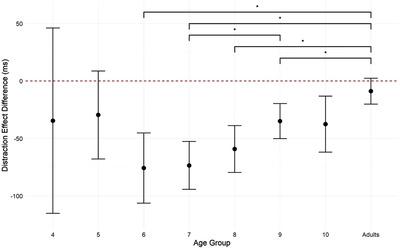Our official English website, www.x-mol.net, welcomes your
feedback! (Note: you will need to create a separate account there.)
Attentional control in middle childhood is highly dynamic—Strong initial distraction is followed by advanced attention control
Developmental Science ( IF 3.1 ) Pub Date : 2022-05-10 , DOI: 10.1111/desc.13275 Sindram Volkmer 1 , Nicole Wetzel 2, 3, 4 , Andreas Widmann 1, 2 , Florian Scharf 5, 6
Developmental Science ( IF 3.1 ) Pub Date : 2022-05-10 , DOI: 10.1111/desc.13275 Sindram Volkmer 1 , Nicole Wetzel 2, 3, 4 , Andreas Widmann 1, 2 , Florian Scharf 5, 6
Affiliation

|
The ability to shield against distraction while focusing on a task requires the operation of executive functions and is essential for successful learning. We investigated the short-term dynamics of distraction control in a data set of 269 children aged 4–10 years and 51 adults pooled from three studies using multilevel models. Participants performed a visual categorization task while a task-irrelevant sequence of sounds was presented which consisted of frequently repeated standard sounds and rarely interspersed novel sounds. On average, participants responded slower in the categorization task after novel sounds. This distraction effect was more pronounced in children. Throughout the experiment, the initially strong distraction effects declined to the level of adults in the groups of 6- to 10-year-olds. Such a decline was neither observed in the groups of the 4- and 5-year-olds, who consistently showed a high level of distraction, nor in adults, who showed a constantly low level of distraction throughout the experimental session. Results indicate that distraction control is a highly dynamic process that qualitatively and quantitatively differs between age groups. We conclude that the analysis of short-term dynamics provides valuable insights into the development of attention control and might explain inconsistent findings regarding distraction control in middle childhood. In addition, models of attention control need to be refined to account for age-dependent rapid learning mechanisms. Our findings have implications for the design of learning situations and provide an additional source of information for the diagnosis and treatment of children with attention deficit disorders.
中文翻译:

儿童中期的注意力控制是高度动态的——强烈的初始注意力分散之后是高级注意力控制
在专注于一项任务时避免分心的能力需要执行功能的运作,这对于成功学习至关重要。我们使用多层次模型从三项研究中汇集了 269 名 4-10 岁儿童和 51 名成年人的数据集,调查了分心控制的短期动态。参与者执行视觉分类任务,同时呈现与任务无关的声音序列,其中包括经常重复的标准声音和很少散布的新声音。平均而言,参与者在听到新声音后对分类任务的反应较慢。这种分散注意力的效果在儿童中更为明显。在整个实验过程中,最初强烈的分心效果下降到 6 至 10 岁儿童组中成年人的水平。这种下降既没有在 4 岁和 5 岁的儿童组中观察到,他们一直表现出高度的分心,也没有在成年人中观察到,他们在整个实验过程中表现出持续低水平的分心。结果表明,分心控制是一个高度动态的过程,在不同年龄组之间存在定性和定量差异。我们的结论是,短期动态分析为注意力控制的发展提供了宝贵的见解,并可能解释关于儿童中期分心控制的不一致发现。此外,注意力控制模型需要改进以解释依赖于年龄的快速学习机制。
更新日期:2022-05-10
中文翻译:

儿童中期的注意力控制是高度动态的——强烈的初始注意力分散之后是高级注意力控制
在专注于一项任务时避免分心的能力需要执行功能的运作,这对于成功学习至关重要。我们使用多层次模型从三项研究中汇集了 269 名 4-10 岁儿童和 51 名成年人的数据集,调查了分心控制的短期动态。参与者执行视觉分类任务,同时呈现与任务无关的声音序列,其中包括经常重复的标准声音和很少散布的新声音。平均而言,参与者在听到新声音后对分类任务的反应较慢。这种分散注意力的效果在儿童中更为明显。在整个实验过程中,最初强烈的分心效果下降到 6 至 10 岁儿童组中成年人的水平。这种下降既没有在 4 岁和 5 岁的儿童组中观察到,他们一直表现出高度的分心,也没有在成年人中观察到,他们在整个实验过程中表现出持续低水平的分心。结果表明,分心控制是一个高度动态的过程,在不同年龄组之间存在定性和定量差异。我们的结论是,短期动态分析为注意力控制的发展提供了宝贵的见解,并可能解释关于儿童中期分心控制的不一致发现。此外,注意力控制模型需要改进以解释依赖于年龄的快速学习机制。











































 京公网安备 11010802027423号
京公网安备 11010802027423号